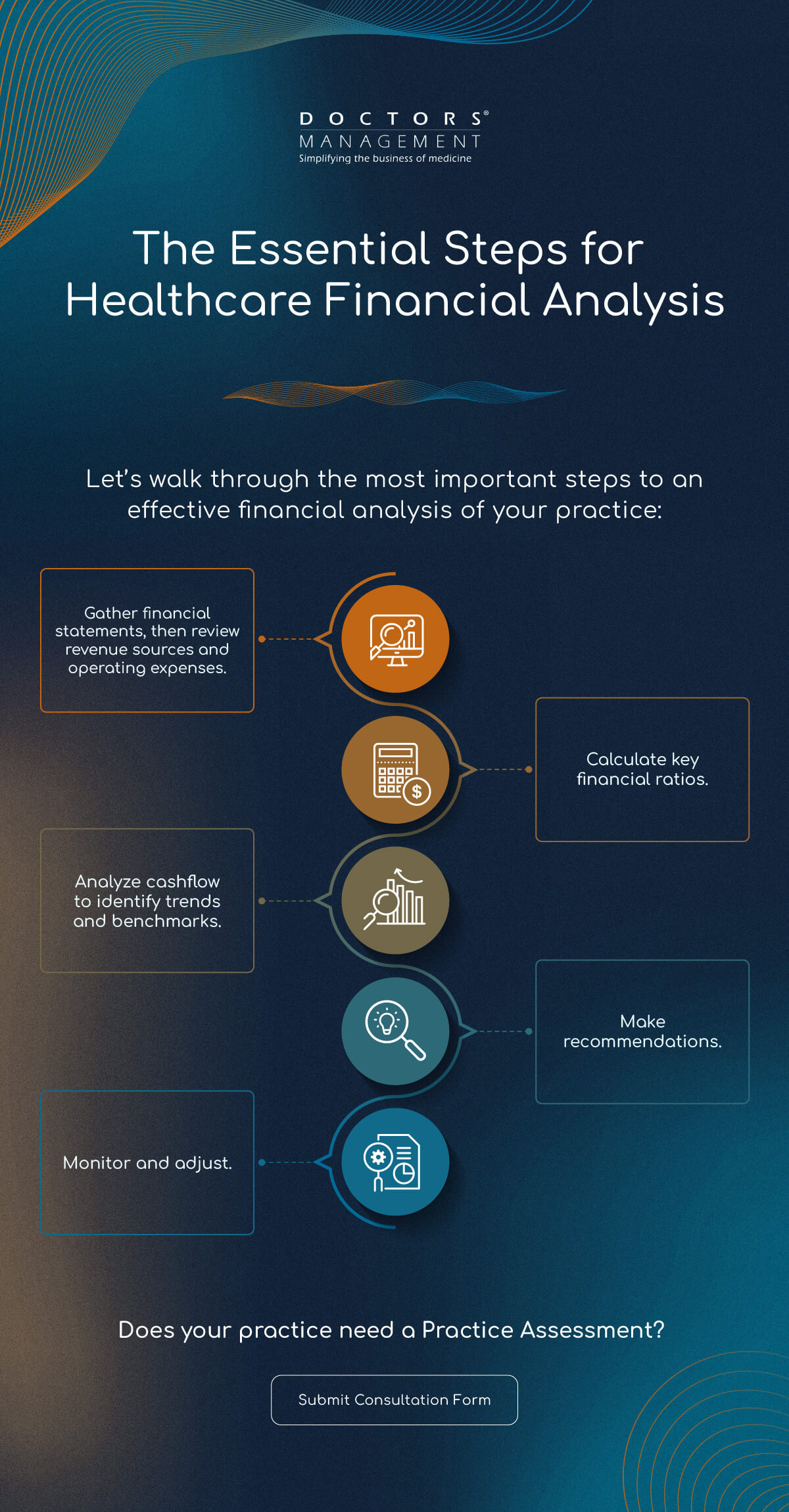June 28, 2023
Unveiling the Pulse of a Medical Practice With Financial Analysis
- by Trevor McElhaney, JD, Director of Consulting
A physician practice is not only dedicated to providing exceptional patient care but also to achieving financial stability and success. Understanding the financial health of a practice requires a comprehensive analysis of its revenue, expenses, profitability, and cash flow. Here, we look at the intricacies of conducting a detailed financial analysis in a medical practice, exploring the key steps and considerations involved. By gaining insights into the healthcare practice’s financial performance, healthcare providers can make informed decisions to streamline business operations to optimize revenue generation, control expenses, and enhance overall profitability. Let’s walk through nine key steps and considerations you should take to understand the health of your practice.
Essential Steps Involved in a Healthcare Financial Analysis
1. Gathering Financial Statements: To initiate a thorough financial analysis, the first step is to gather the practice’s financial statements, which include the income statement, balance sheet, and cash flow statement. These documents provide a snapshot of the practice’s financial position and performance over a specific period, serving as the foundation for deeper analysis.
2. Reviewing Revenue Sources: Identifying and understanding the practice’s primary sources of revenue is crucial. Revenue may stem from various streams such as routine patient visits, telehealth visits, procedures, consultations, diagnostic tests, and other services, sometimes with significantly different levels of reimbursement. A practice may also provide other services with cash-based pricing. By analyzing revenue by category, healthcare professionals can determine the contributions of each source to the overall revenue, thereby gaining insights into the revenue mix and potential areas for growth.
3. Assessing Operating Expenses: Operating expenses play a significant role in determining the profitability of a medical practice. Categorizing expenses such as staff member’s salaries and benefits, rent, utilities, medical supplies, equipment maintenance, EMR system, marketing, and administrative costs helps in understanding cost structures. Evaluating these expenses enables practice administrators to identify areas where cost-saving measures can be implemented without compromising patient care and the workflow of the practice.
4. Calculating Key Financial Ratios: Financial ratios provide meaningful insights into a medical practice’s financial health and performance. By calculating and analyzing key ratios, healthcare professionals can assess profitability, liquidity, efficiency, and debt levels. Profitability ratios, such as gross profit margin and net profit margin, reveal the practice’s ability to generate profits. Liquidity ratios, including the current ratio and quick ratio, measure the practice’s ability to meet short-term financial obligations. Efficiency ratios, such as average collection period and patient-to-physician ratio, offer insights into operational efficiency. Debt ratios, such as debt-to-equity ratio and interest coverage ratio, indicate the practice’s level of debt and its capacity to manage debt obligations. Reviewing accounts receivable, by aging bucket, as well as by specific payers, can also provide actionable insights into revenue sources and the effectiveness of the revenue cycle management team. Comparing these ratios with industry benchmarks allows for benchmarking performance and identifying areas that require improvement.
5. Analyzing Cash Flow: Cash flow analysis is crucial in assessing the inflows and outflows of cash within a medical practice. By reviewing the cash flow statement, healthcare professionals can gain a comprehensive understanding of operating, investing, and financing activities. This analysis helps determine the practice’s cash flow position and its ability to cover expenses and investments. Positive cash flow indicates a healthy financial state, while negative cash flow may require adjustments in operational or financial management.
6. Identifying Trends and Benchmarks: To gain a deeper understanding of the practice’s financial performance, it is essential to compare it with industry benchmarks and historical trends. Identifying significant changes in revenue, expenses, and profitability can shed light on factors influencing the practice’s financial performance. By recognizing areas of strength and weakness, healthcare professionals can develop strategies to leverage their strengths and address any potential issues or inefficiencies.
7. Making Recommendations: Based on the financial analysis, healthcare professionals can identify areas where the practice can improve its financial performance. Recommendations may include strategies to increase revenue, reduce expenses, optimize the revenue cycle management process, negotiate more favorable contracts with suppliers, engage the most significant payers in the patient population for increased reimbursement, and implement additional cost-saving measures. These recommendations should always align with the practice’s goals, vision, and values.
8. Monitoring and Adjusting: Conducting a financial analysis is not a one-time endeavor. Regular monitoring of the practice’s financial performance and ongoing revenue cycle management is crucial to ensure continuous improvement. By comparing actual results with the recommendations made, healthcare professionals can make informed adjustments to their strategies and operations. Adapting to changes in the healthcare landscape and continuously refining financial management practices will lead to sustainable financial success.
A comprehensive financial analysis provides medical practices with valuable insights into their financial performance and enables them to make informed decisions. By analyzing revenue sources, assessing expenses, calculating key financial ratios, analyzing cash flow, and benchmarking against industry standards, healthcare professionals can identify areas for improvement and implement strategies to enhance profitability and financial stability. Regular monitoring and adjustment are crucial for maintaining financial health in an ever-evolving healthcare landscape. Embracing financial analysis as an integral part of practice management ensures that the medical practice can continue to provide high-quality care while achieving long-term financial success.
DoctorsManagement’s experienced management consulting and accounting team assist clients across the county with “keeping score” – a proactive and monthly recording of where the practice has been, where it stands, and where we want to go. A crucial component of the score keeping process is ensuring we have accurate data, detailed and user-friendly financial statements, and a core set of key performance indicators to review every month. Our team understands the nuance and complexity of medical practice management in private practice. Our goal is to help shoulder the burden of those complexities to allow our healthcare provider clients to truly focus on their business.
If you would like guidance on these areas or other matters related to the healthcare industry, our executive contacts are available to assist. Contact us today!









